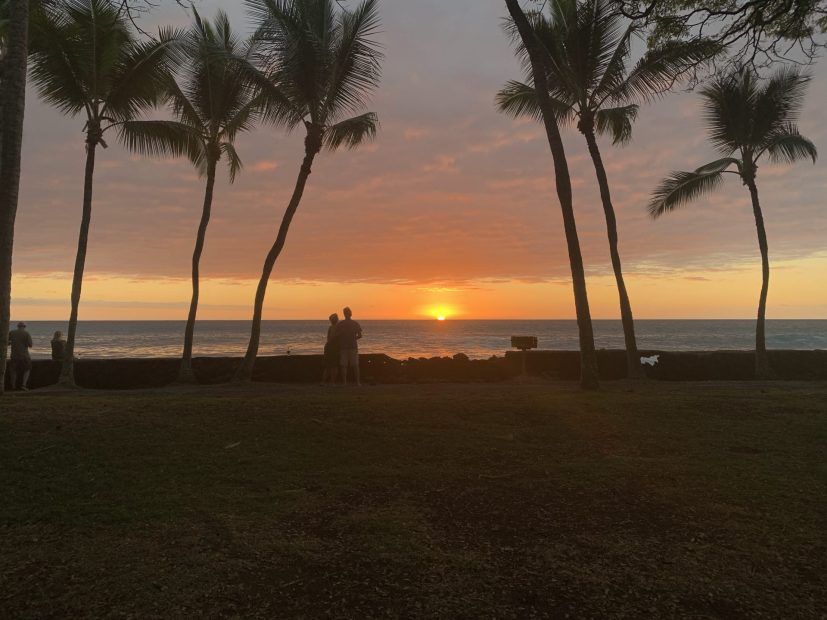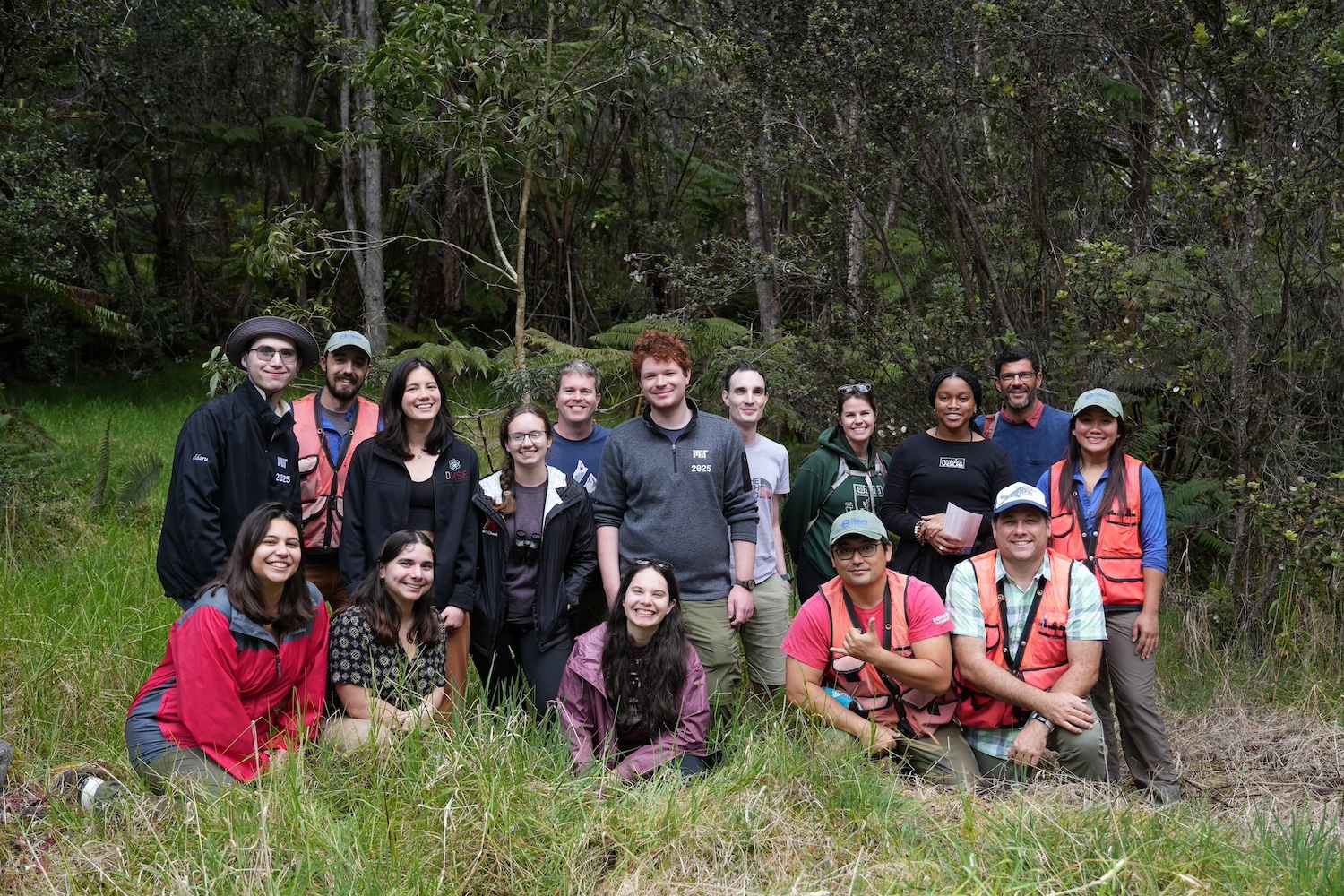Forest Bathing & Other Lessons from Fieldwork in Hawaiʻi

The soil is rocky under my feet, the soft crunch-crunch often the only thing keeping me from my thoughts. Prof. Dave Des Marais said the first three miles would be more tranquil, but, given that my first hike was approximately four days ago, I am not particularly surprised that this is a challenge—calling this a “road” is a generous term, but I know the terrain will only get harder.
Still, it’s hard to feel anything short of wonder and amazement at the way in which the more recent lava flows, with all the rustic beauty of primary secession, turn into lush rainforest “islands,” or kīpuka, in the matter of meters. Inhaling a deep breath, I feel the sun in my face, a welcome change from the Cambridge winter, and I take another step.
My name is Ananda, and I am a junior studying MIT’s newest major, 1-12 (Climate System Science and Engineering). I spent this January during MIT’s Independent Activities Period (IAP) taking Course 1 Civil and Environmental Engineering’s popular environmental fieldwork class, TREX (Traveling Research Environmental eXperience). What better place to combine the theoretical and computational skills we learn in the classroom than by forest stomping in the Big Island of Hawaiʻi?
I knew this would be an incredible experience from the start, but could not have imagined the ways in which I would emerge changed by it. I have been challenged, moved, and inspired by the two weeks we spent on the island.
Here are some of the lessons I took from the field!

1. Just breathe (or, why forest-bathing is FUN)
I have been thinking a lot about nature. In my major and research, I try to think about the human impact on natural systems, whether they are right here in Boston or in the Lake Victoria Basin. And, going into the trip, I knew we would spend many hours surrounded by it, the forests and volcanoes. I was (theoretically) ready for the hikes and machine learning models and many, many shades of green.
And yet.
Nothing could have prepared me for the grandeur of actually being in the middle of the forest, being able to breathe in and just listen to the birds or watch the ohia trees in the wind. One of our days, we visited the NEON (National Ecological Observation Network) site, one of dozens across the country measuring data to better understand the environment and changes over time. Speaking to our guides about my amazement of our surroundings, they mentioned the idea of forest bathing, or finding peace, renewal, and fulfillment from being truly present in a natural environment. And then it clicked—taking this class was an experience in environmental research, certainly, but also on the benefits and joy of being there, of collecting the data and paying close attention to your surroundings. And, yes, sometimes just breathing.

2. Expect the unexpected
Our teaching team, comprised of Prof. Dave Des Marais and Teaching Assistants Dr Meghan Blumstein, Dr Hannah Kenagy, and Timm Haucke, did an amazing job at letting us explore what we wanted while still helping us when our code irrevocably had some problems or when we couldn’t core a tree properly.
One of the coolest moments from the trip was being able to climb up a 105 feet tall eddy flux tower, which measures wind turbulence and carbon and water fluxes between the forest and the atmosphere. In fact, it was so inspiring that, when it came time to do some data analysis, we decided to look at some of the data they had gathered over several years. We ended up studying how carbon uptake changed with volcanic eruptions, a topic we certainly did not expect but which brought many hours of research and a lot of learning. One of the biggest wonders from doing fieldwork is just how little you actually know of the final product when you start. The journey from collecting to analyzing to presenting was non-linear, but an incredibly exciting one!

3. Learn from your surroundings (in more ways than one)
One of our class projects involved flying a drone to gather data about invasive species and develop a computer vision model to spot them in the future. One of our surveyed plots was in partnership with the Kamehameha schools, who own a significant portion of native forests and have a strong land stewardship mission.
While speaking to our guide, Namaka, who brought us through their land, I asked her more about how trees’ value was understood in Hawaiian culture. Her answer went even beyond the inherent worth of these beings and their ecological role; she also spoke of trees as role models, and how we could learn from them. The ‘Ōhi‘a trees, for example, teach us how to be good leaders. They are very important in Hawaiian tradition, not the least because they are part of an important ecological concept of succession, or how an ecosystem is formed after an event such as a volcanic eruption. They are leaders because they are some of the first species to grow in the almost-bare rock, and leaders because they allow others to follow.
I am no stranger to learning from nature (given that that’s… well… a big part of my major), but I was in awe by this perspective, and hope to bring it with me as the new semester begins. I aim to look around and find in my research not only interesting information and data for knowledge, but also a new roadmap for inspiration.
4. Have high expectations… But also high hopes!
There is a lot of work to be done when it comes to the environment. Invasive species are a major challenge to the delicate ecosystems of the islands, and the rising levels of CO2 lead to countless questions on what the future holds. To face these issues head-on, the world needs a lot of labor and research—something that, as I face every day studying climate systems, can be quite difficult.
It is easy to be discouraged when facing such dire predictions about climate and the future, but, interacting with my peers and so many on the island, I found a lot of reason for hope. There are countless individuals working incredibly hard to keep our natural wonders safe and understand more about them, people who inspired me and whose joy and efforts filled me with gratitude. Thank you especially for the teaching team, who, with their jokes, patience, and great driving, helped us go from no data to a final presentation in such a short period of time.
These two weeks were utterly incredible. I did more than I could have ever imagined (hiked eleven miles! Went up Mauna Kea! Climbed meters of volcanic rock! Did not burn peppers on the stove!). And, as a new year begins, I look forward to all the ways that I will continue to grow and learn.


